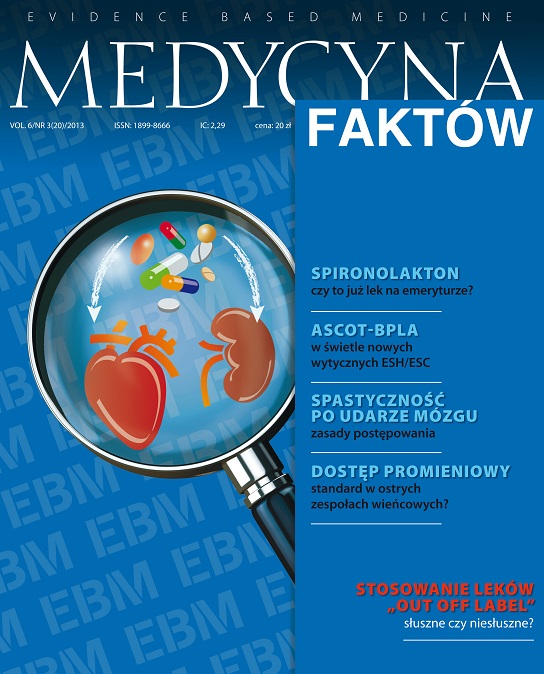High doses of atorvastatin – indications and safety Review article
Main Article Content
Abstract
Statins are indicated for primary and secondary prevention of cardiovascular disease. The current evidence suggests clinical benefits mainly depend on the extent of LDL cholesterol reduction. Atorvastatin is one of the most effective statin used to lower LDL cholesterol level. The degree of reduction depends on the dose and ranges from 39% up to 55% for 80 mg atorvastatin daily. However, intensive atorvastatin treatment is rarely administrated due to concerns regarding the safety profile of such treatment. According to recent studies, lipid-lowering therapy with high doses of atorvastatin is highly effective and safe in short and long term treatment.
Article Details
How to Cite
Konopka , M., & Kuch , M. (2013). High doses of atorvastatin – indications and safety. Medycyna Faktow (J EBM), 6(3(20), 32-37. Retrieved from https://journalsmededu.pl/index.php/jebm/article/view/2404
Issue
Section
Articles
Copyright © by Medical Education. All rights reserved.
References
1. Reiner Z., Catapano A.L., De Backer G. et al.: ESC/EAS Guidelines for the management of dyslipidaemias: The Task Force for the management of dyslipidaemias of the European Society of Cardiology (ESC) and the European Atherosclerosis Society (EAS). Eur. Heart J. 2011; 32: 1769-1818.
2. DRUGS.com. Lipitor.
3. Weng T.C., Yang Y.H., Lin S.J. et al.: A systematic review and meta-analysis on the therapeutic equivalence of statins. J. Clin. Pharm. Ther. 2010; 35: 139-151.
4. Zdrojewski T.: Epidemiologia zaburzeń lipidowych w Polsce. W: Aktualny stan wiedzy na temat statyn. Banach M., Filipiak J.K., Opolski G. (red.). Wydawnictwa Medyczne Termedia, Poznań 2013:17-21.
5. Ray K.K., Cannon C.P., McCabe C.H. et al.: Early and late benefits of high-dose atorvastatin in patients with acute coronary syndromes: results from the PROVE IT-TIMI 22 trial. J. Am. Coll. Cardiol. 2005; 46: 1405-1410.
6. Schwartz G.G., Olsson A.G., Ezekowitz M.D. et al.: Effects of atorvastatin on early recurrent ischemic events in acute coronary syndromes: the MIRACL study: a randomized controlled trial. JAMA 2001; 285: 1711-1718.
7. LaRosa J.C., Grundy S.M., Waters D.D. et al.: Intensive lipid lowering with atorvastatin in patients with stable coronary disease. N. Engl. J. Med. 2005; 352: 1425-1435.
8. Waters D.D., Guyton J.R., Herrington D.M. et al.: Treating to New Targets (TNT) Study: does lowering low-density lipoprotein cholesterol levels below currently recommended guidelines yield incremental clinical benefit? Am. J. Cardiol. 2004; 93: 154-8.
9. Amarenco P., Bogousslavsky J., Callahan A. 3rd et al.: Stroke Prevention by Aggressive Reduction in Cholesterol Levels (SPARCL). High-dose atorvastatin after stroke or transient ischemic attack. N. Engl. J. Med. 2006; 355: 549-559.
10. Nicholls S.J., Ballantyne C.M., Barter P.J. et al.: Effect of the intensive statin regiments on progression of coronary disease. N. Engl. J. Med. 2011; 365: 2078-2087.
11. Newman C., Tsai J., Szarek M. et al.: Comparative safety of atorvastatin 80 mg versus 10 mg derived from analysis of 49 completed trials in 14,236 patients. Am. J. Cardiol. 2006; 97: 61-67.
2. DRUGS.com. Lipitor.
3. Weng T.C., Yang Y.H., Lin S.J. et al.: A systematic review and meta-analysis on the therapeutic equivalence of statins. J. Clin. Pharm. Ther. 2010; 35: 139-151.
4. Zdrojewski T.: Epidemiologia zaburzeń lipidowych w Polsce. W: Aktualny stan wiedzy na temat statyn. Banach M., Filipiak J.K., Opolski G. (red.). Wydawnictwa Medyczne Termedia, Poznań 2013:17-21.
5. Ray K.K., Cannon C.P., McCabe C.H. et al.: Early and late benefits of high-dose atorvastatin in patients with acute coronary syndromes: results from the PROVE IT-TIMI 22 trial. J. Am. Coll. Cardiol. 2005; 46: 1405-1410.
6. Schwartz G.G., Olsson A.G., Ezekowitz M.D. et al.: Effects of atorvastatin on early recurrent ischemic events in acute coronary syndromes: the MIRACL study: a randomized controlled trial. JAMA 2001; 285: 1711-1718.
7. LaRosa J.C., Grundy S.M., Waters D.D. et al.: Intensive lipid lowering with atorvastatin in patients with stable coronary disease. N. Engl. J. Med. 2005; 352: 1425-1435.
8. Waters D.D., Guyton J.R., Herrington D.M. et al.: Treating to New Targets (TNT) Study: does lowering low-density lipoprotein cholesterol levels below currently recommended guidelines yield incremental clinical benefit? Am. J. Cardiol. 2004; 93: 154-8.
9. Amarenco P., Bogousslavsky J., Callahan A. 3rd et al.: Stroke Prevention by Aggressive Reduction in Cholesterol Levels (SPARCL). High-dose atorvastatin after stroke or transient ischemic attack. N. Engl. J. Med. 2006; 355: 549-559.
10. Nicholls S.J., Ballantyne C.M., Barter P.J. et al.: Effect of the intensive statin regiments on progression of coronary disease. N. Engl. J. Med. 2011; 365: 2078-2087.
11. Newman C., Tsai J., Szarek M. et al.: Comparative safety of atorvastatin 80 mg versus 10 mg derived from analysis of 49 completed trials in 14,236 patients. Am. J. Cardiol. 2006; 97: 61-67.

